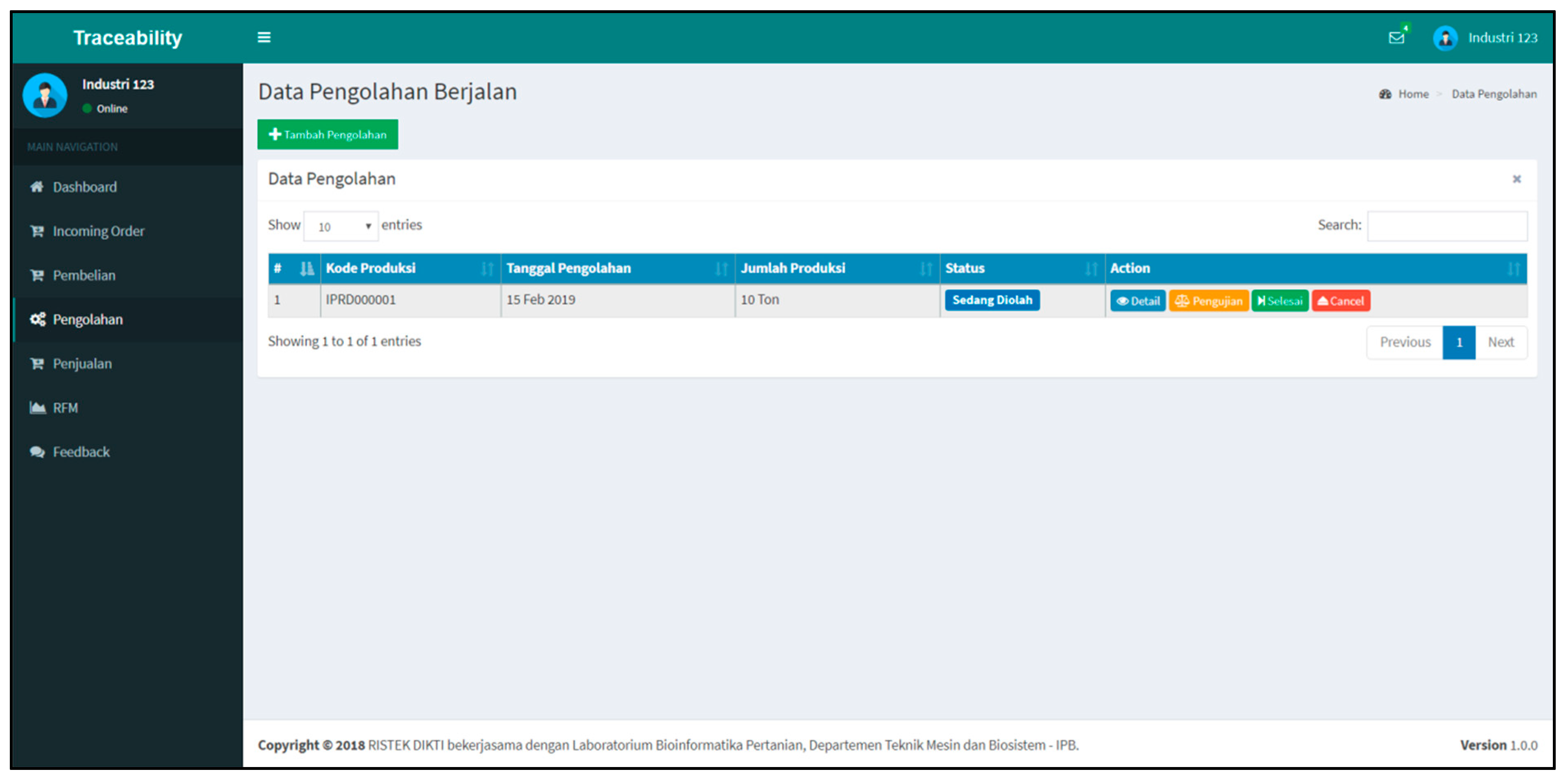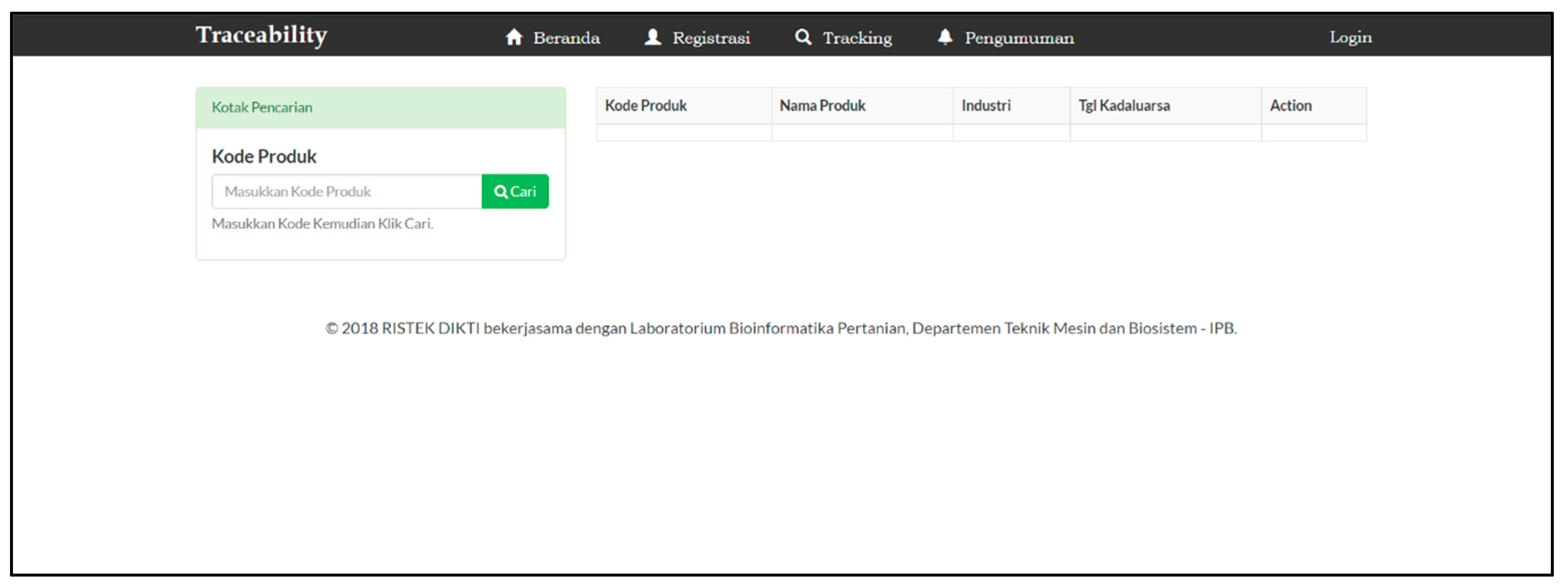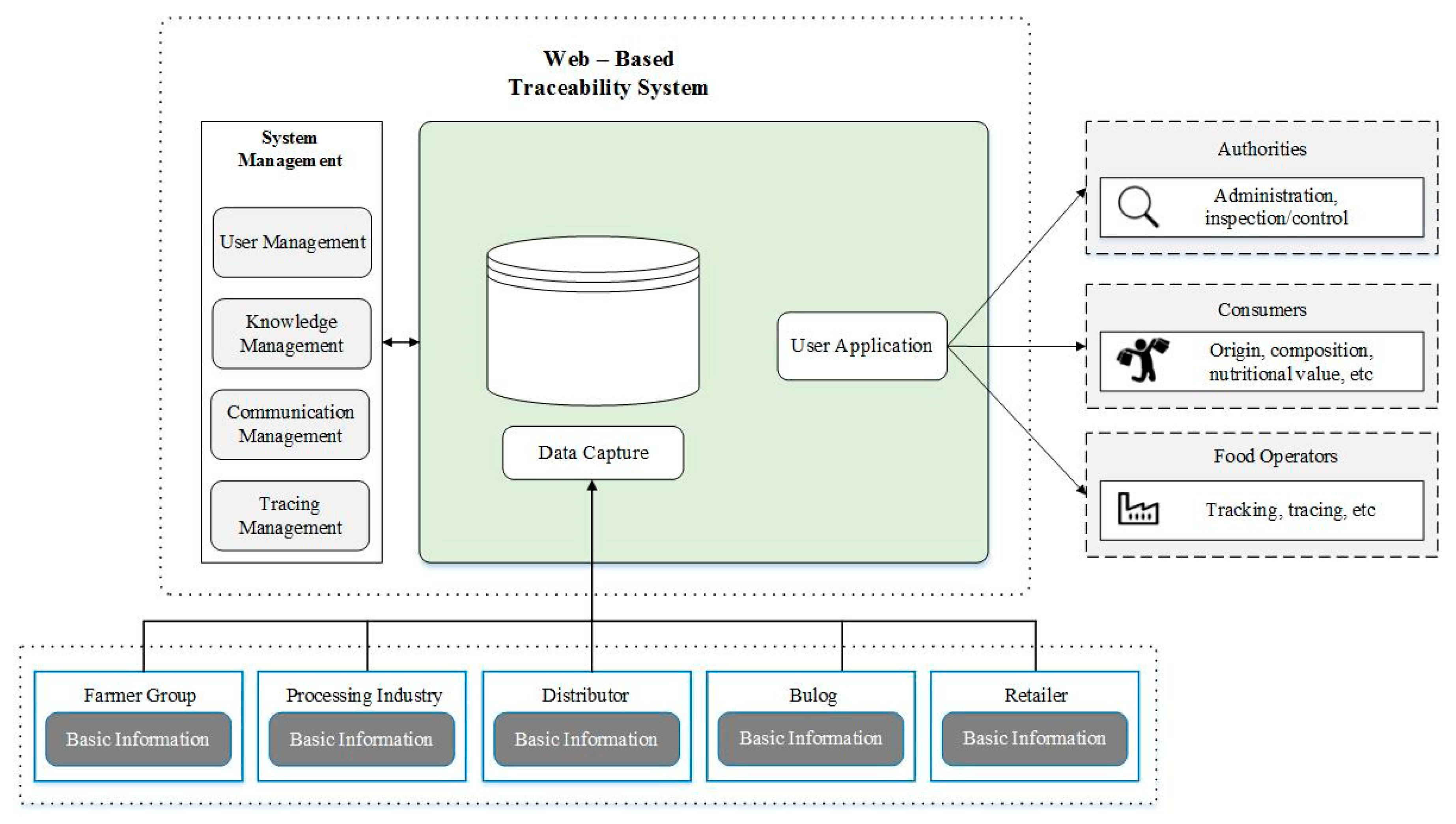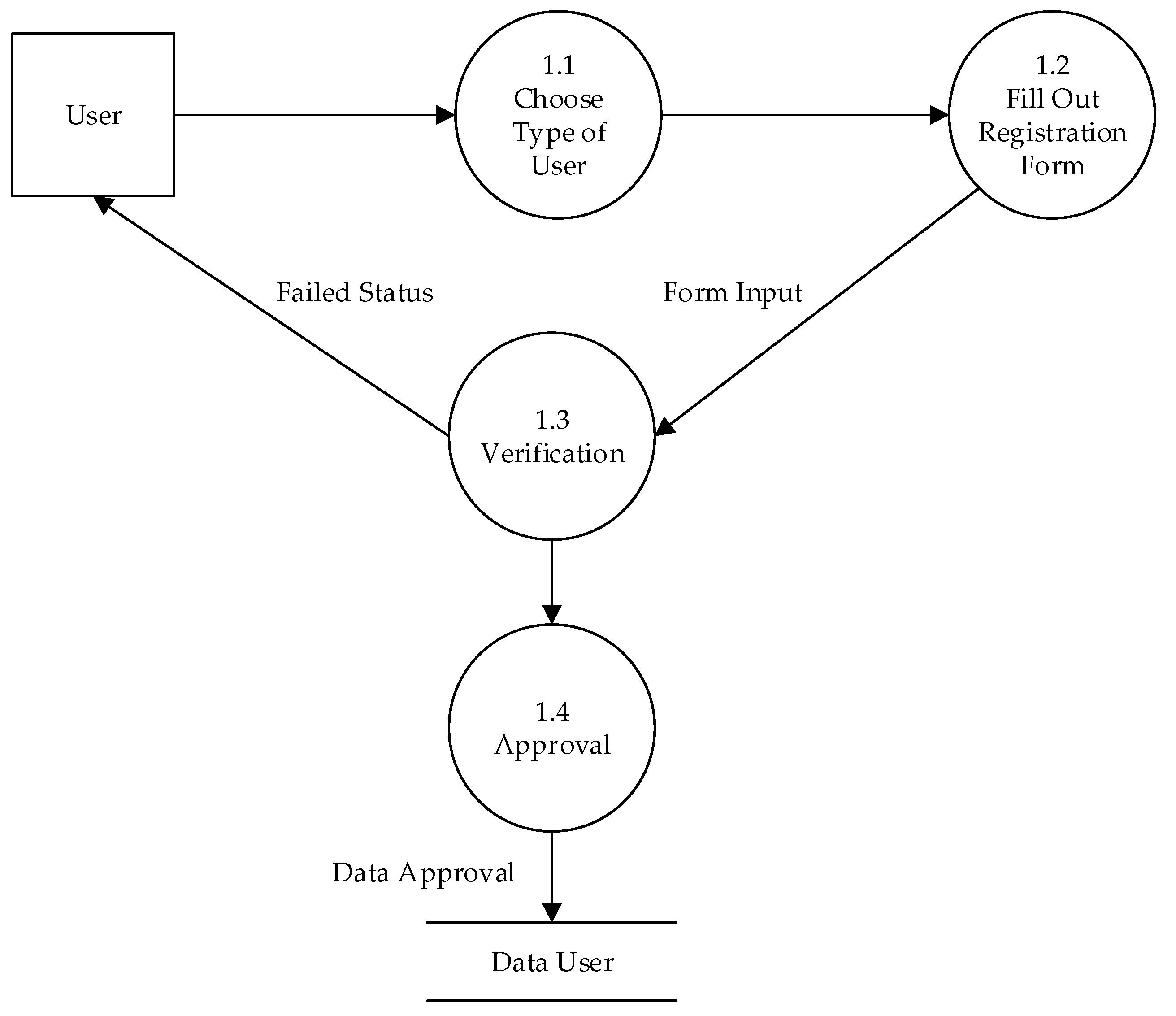Development of a Smart Traceability System for the Rice Agroindustry Supply Chain in Indonesia
Abstract
:1. Introduction
2. Literature Review
3. Methodology
4. Rice Agroindustry Supply Chain
5. Traceability System Development
5.1. System Architecture
5.2. Traceability System Analysis
5.3. Analysis of Business Intelligent Systems
5.3.1. Customer Relationship Management
5.3.2. Supplier Selection
6. System Implementation
7. Managerial Implication
8. Conclusions
Author Contributions
Funding
Conflicts of Interest
Appendix A






References
- Codex Alimentarius Commission. Principles for traceability/Product tracing as a tool within a food inspection and certification system. CAC/GL 2006, 60, 1–4. [Google Scholar]
- Thakur, M.; Hurburgh, C.R. Framework for implementing traceability system in the bulk grain supply chain. J. Food Eng. 2009, 95, 617–626. [Google Scholar] [CrossRef]
- European Union. Council Regulation (EC) No. 104/2000 of 17 December 1999 on the common organization of the markets in fishery and aquaculture products. Off. J. Eur. Communities 1999, 17, 1–31. [Google Scholar]
- Yanuarti, A.R.; Afsari, M.D. Rice Commodity Profile; Ministry of Trade: Jakarta, Indonesia, 2016; pp. 1–37.
- PUSDATIN. Outlook Komoditas Pertanian Sub Sektor Tanaman Pangan; Kementerian Pertanian: Jakarta, Indonesia, 2016.
- Suismono; Damiadi, S. Prospect of SNI labeled rice. J. Pangan 2010, 19, 30–39. [Google Scholar]
- Aminah, S. Analisis kandungan klorin pada beras yang beredar di pasar tradisional makassar dengan metode argentometri volhard (Analysis of chlorin content on rice in makassar traditional market using volhard argentometry method). In Proceedings of the National Seminar on Food, Technology and Entrepreneurship, Kota Malang, Indonesia, 28 February 2019; pp. 171–175. [Google Scholar]
- Yude, S.A.; Lestari, Y.; Endrinaldi, E. Identifikasi dan penentuan kadar klorin pada beras yang dijual di pasar raya padang (Identification and determination of cholrin content in rice at padang city market). J. Kesehat. Andalas 2016, 5. [Google Scholar]
- Kresna, B.A.; Seminar, K.; Marimin. Developing a traceability system for tuna supply chain. Int. J. Supply Chain Manag. 2017, 6, 52–62. [Google Scholar]
- Dwiyitno, D. Implementasi sistem ketertelusuran pada produk perikanan (Implementation of traceability system in fishery products). Squalen Bull. Mar. Fish. Postharvest Biotechnol. 2009, 4, 99–104. [Google Scholar] [CrossRef]
- Purwandoko, P.B.; Seminar, K.B. Framework for Design of Traceability System on Organic Rice Certification. In IOP Conference Series: Earth and Environmental Science; IOP Publishing: Bristol, UK, 2018; p. 012044. [Google Scholar]
- Karlsen, K.; Sørensen, C.; Forås, F.; Olsen, P. Critical criteria when implementing electronic chain traceability in a fish supply chain. Food Control 2011, 22, 1339–1347. [Google Scholar] [CrossRef]
- Hwang, Y.M.; Moon, J.; Yoo, S. Developing a RFID-based food traceability system in Korea ginseng industry: Focused on the business process reengineering. Int. J. Control Autom. 2015, 8, 397–406. [Google Scholar] [CrossRef]
- Qian, J.P.; Yang, X.T.; Wu, X.M.; Zhao, L.; Fan, B.L.; Xing, B. A traceability system incorporating 2D barcode and RFID technology for wheat flour mills. Comput. Electron. Agric. 2012, 89, 76–85. [Google Scholar] [CrossRef]
- Magliulo, L.; Genovese, L.; Peretti, V.; Murru, N. Application of ontologies to traceability in the dairy supply chain. Agric. Sci. 2013, 4, 41–45. [Google Scholar] [CrossRef] [Green Version]
- Sudibyo, A. Sistem ketertelusuran pada industri pangan dan produk hasil pertanian (Traceability system in food industry and agricultural product). War. Ind. Has. Pertan. 2012, 29, 43–62. [Google Scholar]
- Pinto, D.; Castro, I.; Vicente, A. The use of TIC’s as a managing tool for traceability in the food industry. Food Res. Int. 2006, 39, 772–781. [Google Scholar] [CrossRef]
- Bosona, T.; Gebresenbet, G. Food traceability as an integral part of logistics management in food and agricultural supply chain. Food Control 2013, 33, 32–48. [Google Scholar] [CrossRef]
- Kumar, V.; Hallqvist, C.; Ekwall, D. Developing a framework for traceability implementation in the textile supply chain. Systems 2017, 5, 33. [Google Scholar] [CrossRef]
- Vanany, I.; Andri, K.B.; Mardiyanto, R.; Puspita, N.F.; Winarsih, W.H. An electronic traceability system for an Indonesian fresh fruit supply chain. IPTEK J. Proc. Ser. 2015, 1. [Google Scholar] [CrossRef]
- Vanany, I.; Mardiyanto, R.; Ijtihadie, R.M.; Andri, K.B.; Engelseth, P. Developing electronic mango traceability in Indonesia. In Supply Chain Forum: An International Journal; Taylor & Francis: Didecott, UK, 2016; pp. 26–38. [Google Scholar]
- Rizqya, E.; Seminar, K.; Buono, A. Prototype development of a traceability system for coconut palm sugar supply chain Indonesia. Int. J. Res. Sci. Manag. 2017, 4, 69–76. [Google Scholar] [CrossRef]
- Marimin, M.N. Aplikasi teknik pengambilan keputusan dalam manajemen rantai pasok (Application of decision making techniques in supply chain management). Bogor (ID) IPB Pr. 2010, in press. [Google Scholar]
- Purwandoko, P.B.; Seminar, K.B. Design Framework of a Traceability System for the Rice Agroindustry Supply Chain in West Java. Information 2019, 10, 218. [Google Scholar] [CrossRef]
- Lankhorst, M. Enterprise Architecture at Work; Springer: Berlin/Heidelberg, Germany, 2009; Volume 352. [Google Scholar]
- Jen, L.R.; Lee, Y.J.; Working Group. IEEE Recommended Practice for Architectural Description of Software-Intensive Systems. 2000. Available online: http://citeseerx.ist.psu.edu/viewdoc/summary?doi=10.1.1.102.9904 (accessed on 23 September 2019).
- Xuemin, Z.; Zhiming, S.; Ping, G. The process of information systems architecture development. Procedia Eng. 2012, 29, 775–779. [Google Scholar] [CrossRef]
- Seminar, K.; Marimin, K.B.; Arkeman, Y.; Wicaksono, A. IT based supply chain traceability of tuna fish. In Proceedings of the AFITA Conference Korea, Suncheon, Korea, 21–24 June 2016. [Google Scholar]
- Kassahun, A.; Hartog, R.; Sadowski, T.; Scholten, H.; Bartram, T.; Wolfert, S.; Beulens, A. Enabling chain-wide transparency in meat supply chains based on the EPCIS global standard and cloud-based services. Comput. Electron. Agric. 2014, 109, 179–190. [Google Scholar] [CrossRef]
- Satzinger, J.; Jackson, R.; Burd, S. Systems Analysis and Design in a Changing; Course Technology, Cengage Learning: Boston, MA, USA, 2010. [Google Scholar]
- Isik, O.; Jones, M.C.; Sidorova, A. Business intelligence (BI) success and the role of BI capabilities. Intell. Syst. Account. Financ. Manag. 2011, 18, 161–176. [Google Scholar] [CrossRef]
- Moniruzzaman, M.; Kurnia, S.; Parkes, A.; Maynard, S.B. Business Intelligence and Supply Chain Agility. arXiv 2016, arXiv:1606.03511. [Google Scholar]
- Khajvand, M.; Zolfaghar, K.; Ashoori, S.; Alizadeh, S. Estimating customer lifetime value based on RFM analysis of customer purchase behavior: Case study. Procedia Comput. Sci. 2011, 3, 57–63. [Google Scholar] [CrossRef] [Green Version]
- Qiasi, R.; Baqeri-Dehnavi, M.; Minaei-Bidgoli, B.; Amooee, G. Developing a model for measuring customer’s loyalty and value with RFM technique and clustering algorithms. J. Math. Comput. Sci. 2012, 4, 172–181. [Google Scholar] [CrossRef]
- Özbek, A. Supplier selection with fuzzy TOPSIS. J. Econ. Sustain. Dev. 2015, 6, 114–125. [Google Scholar]











© 2019 by the authors. Licensee MDPI, Basel, Switzerland. This article is an open access article distributed under the terms and conditions of the Creative Commons Attribution (CC BY) license (http://creativecommons.org/licenses/by/4.0/).
Share and Cite
Purwandoko, P.B.; Seminar, K.B.; Sutrisno; Sugiyanta. Development of a Smart Traceability System for the Rice Agroindustry Supply Chain in Indonesia. Information 2019, 10, 288. https://doi.org/10.3390/info10100288
Purwandoko PB, Seminar KB, Sutrisno, Sugiyanta. Development of a Smart Traceability System for the Rice Agroindustry Supply Chain in Indonesia. Information. 2019; 10(10):288. https://doi.org/10.3390/info10100288
Chicago/Turabian StylePurwandoko, Pradeka Brilyan, Kudang Boro Seminar, Sutrisno, and Sugiyanta. 2019. "Development of a Smart Traceability System for the Rice Agroindustry Supply Chain in Indonesia" Information 10, no. 10: 288. https://doi.org/10.3390/info10100288





